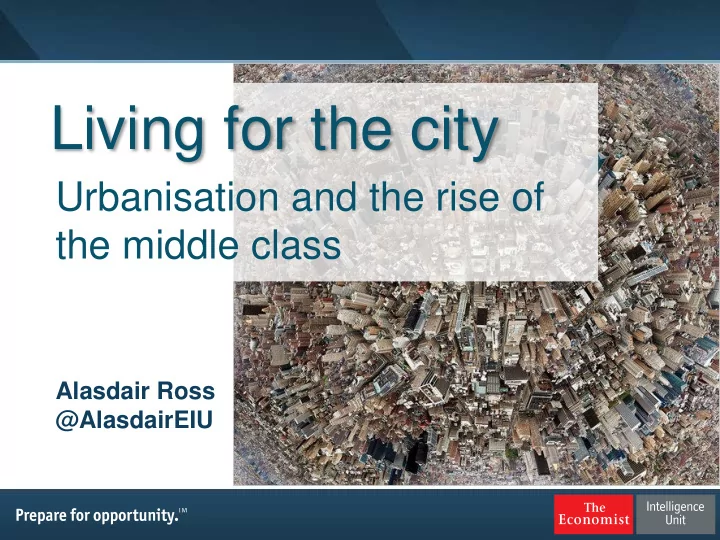

Living for the city Urbanisation and the rise of the middle class Alasdair Ross @AlasdairEIU
Urbanisation: The great transformation “ We are currently in the middle of the largest migration in human history, as over two billion people, a third of humanity, move from rural to ” urban areas Doug Saunders - Arrival City
Urbanisation: The key trends In 2007- 50 world’s cities will absorb 3.1bn 90 more people 80 600 urban centres generate about 60 percent 70 of global GDP 60 Urban development moving southwards and 50 eastward 40 30 Urban populations are richer, women are 20 more empowered 10 Population of world’s countryside will stop 0 growing in 2019 1950 1960 1970 1980 1990 2000 2010 2020 In 2000-30 urban population of Asia & Africa Africa E Asia Europe will double Lat Am US World By 2100 75% of world’s population will be urban Urban populations. %. Source: UN.
The world is middle class Source: Free material from www.gapminder.org
Fat around the middle The global middle class hit 2.1 billion people in 2015. Almost exactly half of the global middle class lives in Asia. China has by far the largest middle class (301m), but it is heavily weighted towards the lower middle class. The US middle class is around half its population. It is perhaps smaller than observers expect, but this is in part because the upper class is large (as is the lower class). Africa’s middle class (144 million) is almost as large as the United States middle class (161 million). Around half of Africa’s middle class lives in North Africa.
Spreading wealth 2030 2005 Source: EIU Canback
Not everywhere is growing While megacities prosper, some mid-tier cities are shrinking Migration: Emigration, national and international Industrial evolution Demographics: Declining births, rising life expectancy Immigration can help, as can ‘right - sizing’ – with bulldozers Mainly an advanced-country problem — for now Pattern set in US, Europe, Japan Over past three years a third of Germany's cities have lost population. Over the next five, half will The future for many developing market cities China’s population will fall from 2050
A matter of perspective – The world in 2025 Children 1 Households >$20k 2 Per Capita GDP GDP growth 1 Oslo Shanghai Kinshasa Tokyo 2 Doha Beijing Karachi Shanghai 3 Bergen New York Dhaka Beijing 4 Macau Tianjin Mumbai Sao Paulo 5 Trondheim Chongqing Kolkata Chongqing 6 Bridgeport Shenzhen Lagos New York 7 Hwasong Guangzhou Delhi London 8 Asan Nanjing Mexico City Mumbai 9 San Jose Hangzhou New York Delhi 10 Yosu Chungdu Manila Mexico City Source: McKinsey Global Institute
China: Wealth and development — the virtuous cycle 2009 Donguan Year in which average 2011 2012 2013 disposable income per capita Hangzhou Beijing Baotou exceeds RMB30,000 Guangzhou Jinan Hothot Ningbo Nanjing Qingdao Suzhou Wuxi Taizhou Shenzhen Xiamen Tianjin Shanghai Yantai 2014 2015 2016 Changsha Fuzhou Anyang Dongying Langfan Changchun Maanshan Harbin Chengdu Wuhan Hefei Dalian Xi’an Jining Guilin Yangzhou Linyi Huainan Zhongshan Nanchang Jiaozuo Zibo Shenyang Kunming Shijiazhuang Luoyang 2017 Tai’an Nanning Anshan Tangshan Pingdingshan Datong Weifang Wuhu Hengyang Xiangtan Zhangjiakou Liuzhou Xiangfan 2019 Panzhihua Xuzhou Qinhuangdao Zhengzhou Daqing Xiangfan Zhuzhou Huaibei Zhaozhuang Qiqihar Zhuhai 2018 Jilin Zunyi Chaoyang Changde Taiyuan Guiyan Xingtai Source: Access China, Economist Intelligence Unit. Haikou Luoyang Huainan
Africa’s opportunity Major African cities Turkey Istanbul: 13.5m Ankara: 4.7m Izmir: 3.8m UAE Dubai: 1.95m Abu Dhabi: .65m 5 countries to watch Additional urban population by 2020 1 Nigeria 16m 2 Egypt 8m 3 Tanzania 7.7m 4 Algeria 6.4m 5 Ethiopia 6m Turkey 11.7m Source: EIU
Country life - The impact on the rural economy Key question: Living standards lower outside cities, so key target for poverty reduction Backward linkages Growing cities need feeding Driving up agricultural productivity Reduced rural labour supply forces improvements in productivity, driving wage increase It’s not just farming Urban demand encourages commuting and non-farm activity, services, small industry Remittances Return on initial investment by rural families to fund their urban pioneer Driving up rural land values Re-sale and collateral value of farmland, particularly close to cities Driving down prices Cities, with economies of scale and competitive markets, contribute to restraining inflation at the national level
When things go wrong – Fragile cities Risk factors: The pace of urbanization Faster growing cities generate more instability and struggle for coherence Income and social inequality Wide differentials foment resentment and make administration tougher Youth unemployment A young population promises a demographic bonanza, but can sour if job creation lags Homicidal and criminal violence Usually tightly focused on high-risk areas, crime can act as a drag on activity city-wide Poor access to key services, Tends to ‘lock out’ human capital Exposure to climate threats - are more serious than others. Resilience and ‘ bouncebackability ’
Recommend
More recommend